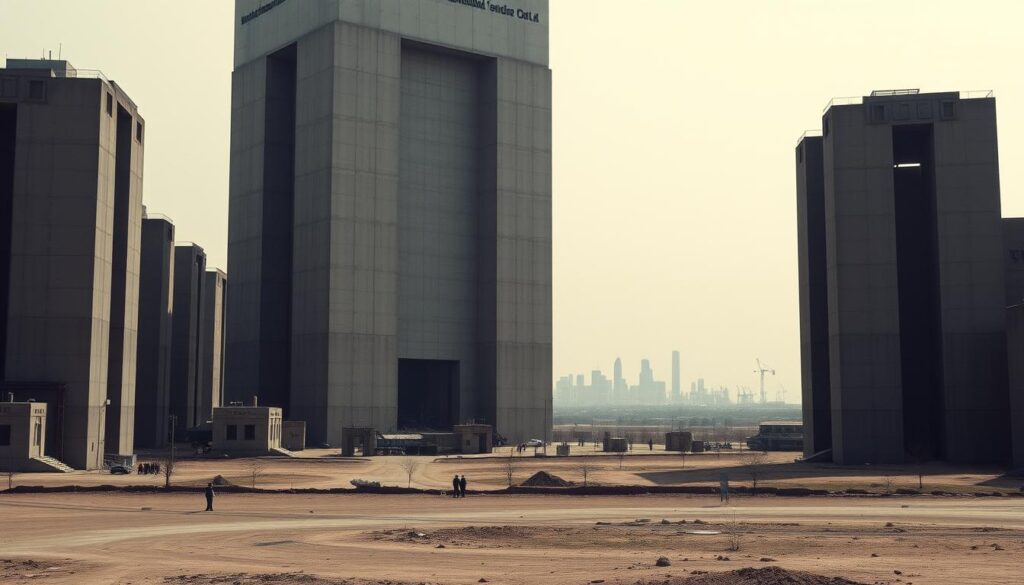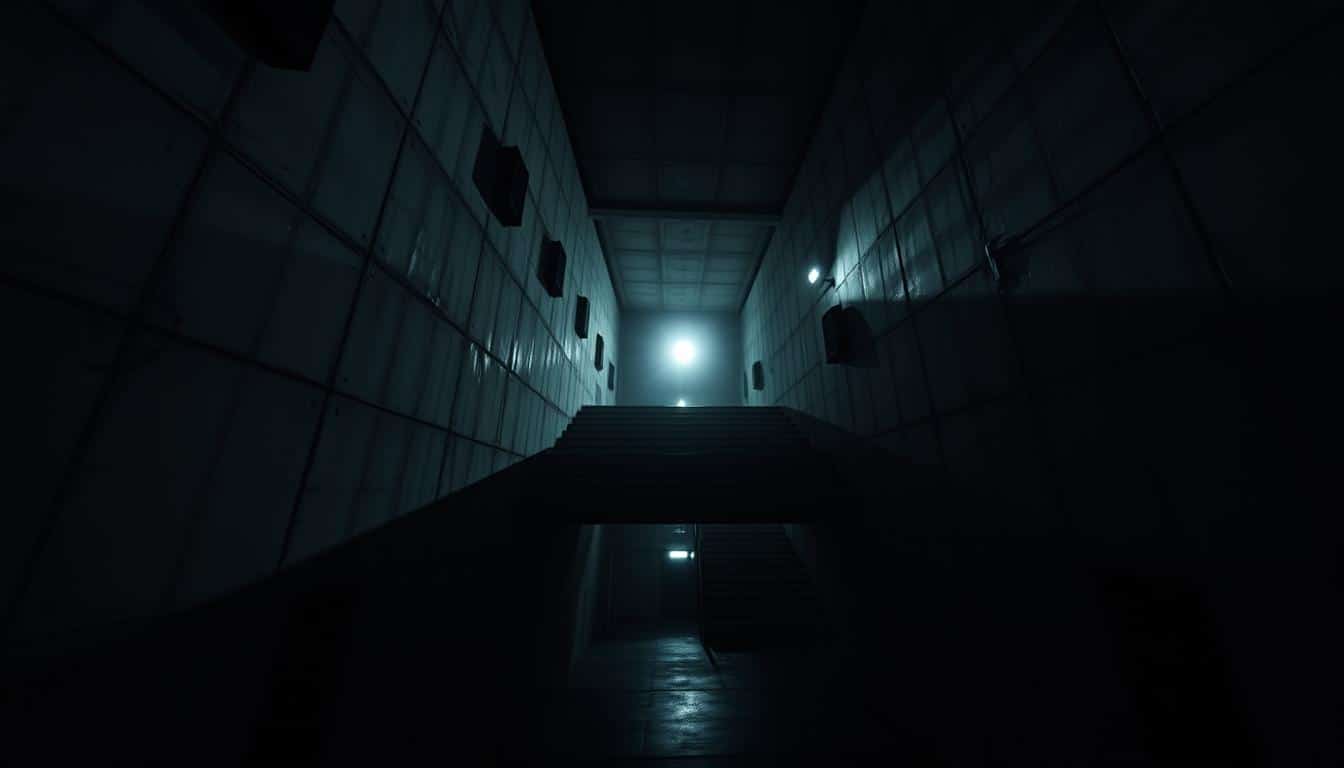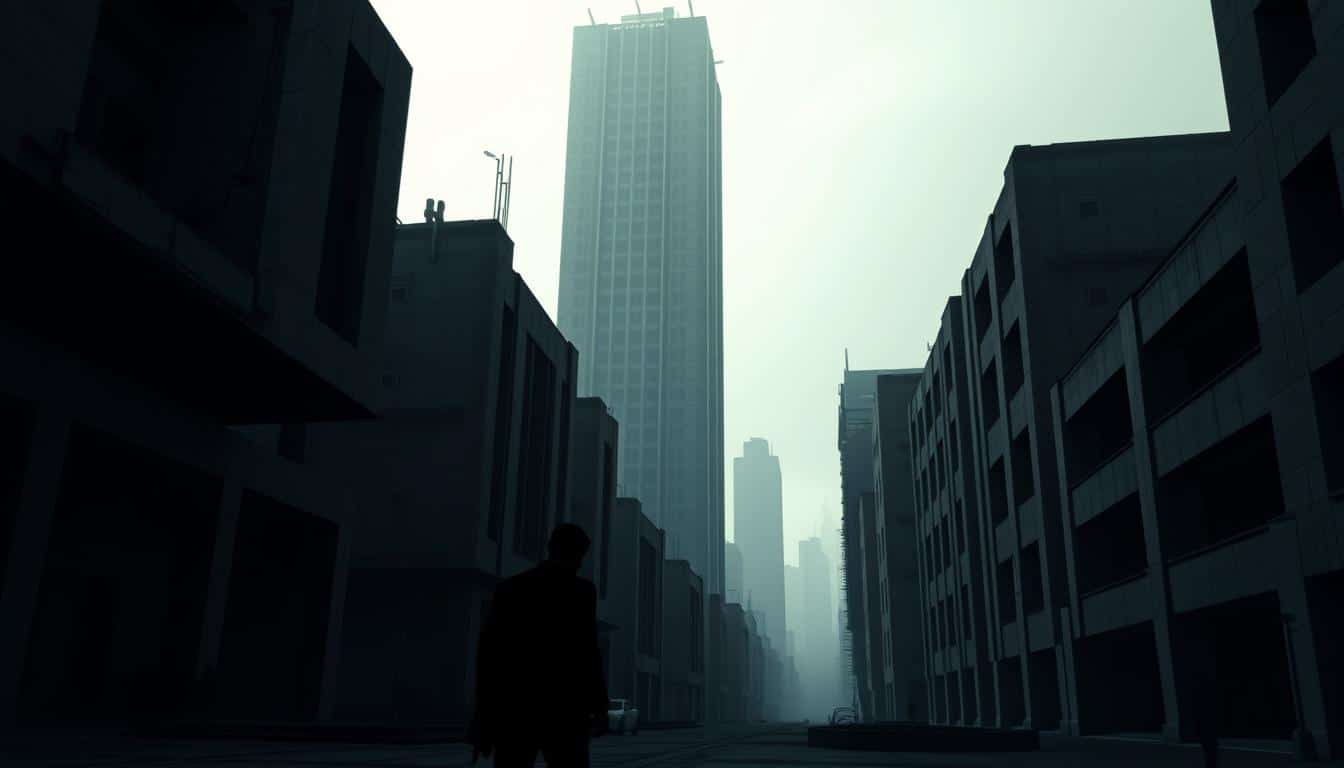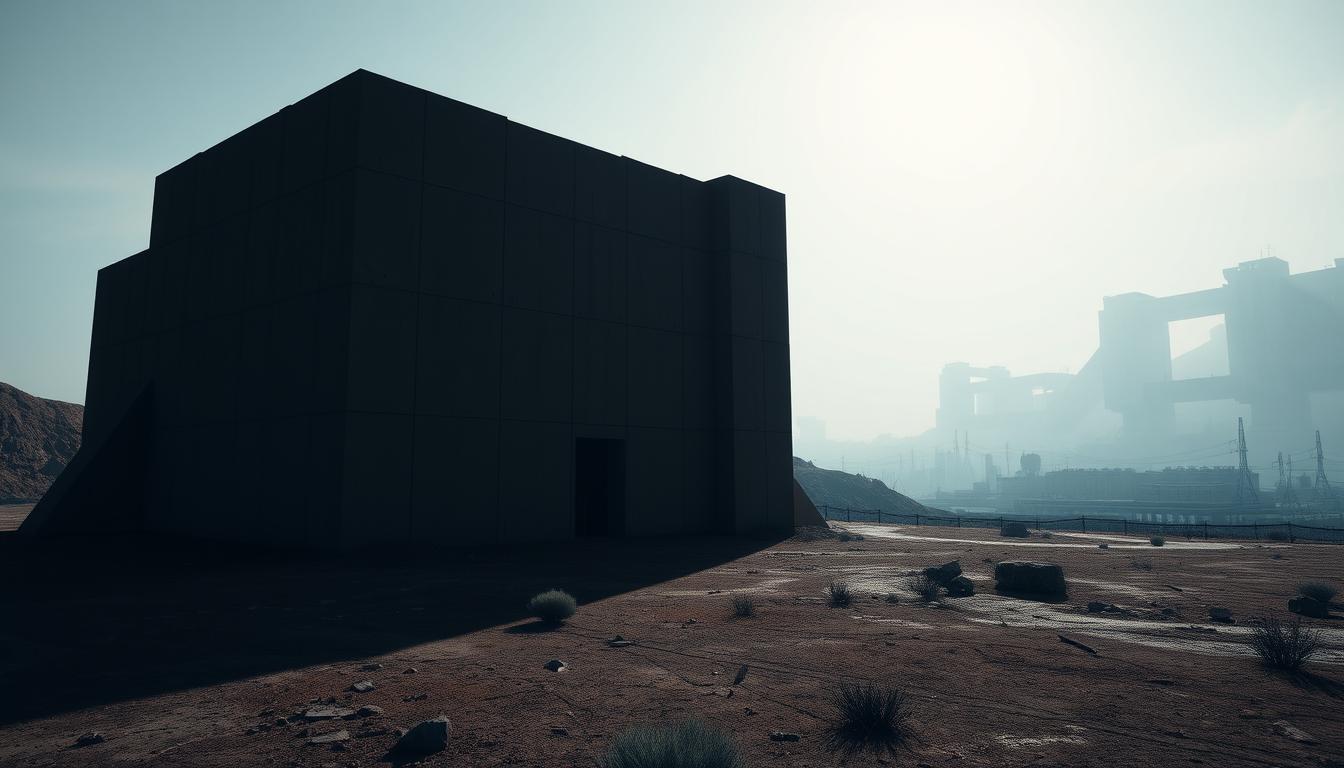In psychological horror games, brutalist aesthetics have become a key design element. These designs, with their sharp concrete structures and big, block-like forms, boost the game’s feel. They make the game world more immersive, pulling players into scenes filled with tension and worry.
This style of architecture doesn’t just shape the surroundings. It also triggers strong emotions, which are vital in horror games. This article will look into how brutalist architecture’s unique qualities intensify the scary stories in these games.
Introduction to Brutalist Architecture
Brutalism became popular in the mid-20th century, reflecting post-war hope and practical needs. It’s known for its raw concrete use and big shapes. The style puts function before beauty. It shows off the rough materials, often leaving them raw to show their real texture. This fits well with what architects in the 20th century valued.
Concrete buildings are key to Brutalism, bringing a feeling of lastingness and heaviness. These buildings get mixed reviews from people. While some praise their strong look and social meanings, others find them too stark and unwelcoming. This divide in opinions affects experiences in psychological horror games, making brutalist settings more eerie.

Historical Context of Brutalism in Gaming
The history of gaming is full of artistic influences, especially from the 90s. Back then, developers often used Brutalism in their games. This wasn’t just for looks but because of the tech limits of that era. Games like Quake and GoldenEye had simple, yet striking, concrete environments. These settings offered players a deep sense of immersion unlike any other.
Games began to feature large, imposing buildings that made players feel both powerful and isolated. The rough, bare surfaces typical of Brutalism deepened the emotional impact. This made them key to the game’s experience. Games like Medal of Honor used Brutalism to make their stories more intense and engaging.
As games have advanced, developers are revisiting Brutalism. They see its historical value in telling complex stories and evoking emotions. By tapping into Brutalism’s roots from the 90s, modern games are using it as a vivid narrative tool. This approach has struck a chord with players, making games more meaningful.
The Emotional Impact of Brutalist Aesthetics
Brutalist architecture has a special way of stirring deep feelings in people. Its big, stark concrete buildings can make you feel uneasy or alone. These feelings help make psychological horror games more real and scary.
How buildings look and the feelings they stir up change how players act in games. Brutalism’s raw look can mirror real-world problems, making games feel more intense. Studies show that our surroundings can affect how we feel. This makes brutalism a great fit for horror games.
The style’s sharp angles and tough materials make horror games even more creepy. Brutalist design touches our feelings, increasing the scare factor. It also gets us thinking about bigger issues in society. This blend of building design and feelings turns game backgrounds into something both scary and deep.
Brutalist Aesthetics in Psychological Horror Gaming
Brutalist aesthetics are key in psychological horror games. The bold structures of brutalism link the game’s architecture with the player’s feelings. Confusing layouts and harsh materials build tension and draw players deeper into eerie stories.
The connection between architectural styles and player emotions
Architecture shapes how players feel in a game. Brutalism’s concrete and basic style often show feelings of being alone and sad. Open areas and strict lines make players feel exposed and lost. This makes the game more intense and engaging.
Case studies of games utilizing Brutalism effectively
Some games show how well brutalist aesthetics work for psychological horror. NaissanceE uses huge, stark buildings to make players feel lost and on edge. This setting adds excitement and fear to the gaming experience.
Control is another game that uses brutalism to boost its story. The Federal Bureau of Control’s building makes the game feel more mysterious. Its design affects how players see and explore the game world. These examples prove that architecture and emotion work together to deepen the horror in games.
NaissanceE: A Cult Classic in Brutalism
NaissanceE shows how brutalist architecture can deeply immerse players in games. Created by Mavros Sedeño, it takes cues from real brutalist buildings. It offers a unique take on architecture to make players feel deeply involved in its eerie settings.
Exploring the game’s architectural influences
The game’s design sticks closely to brutalism, affecting how players feel. It uses monochrome visuals and unreal spaces to create a feeling of being lost and uneasy. When players move through vast concrete scenes, they feel more connected to the game.
This careful mix of architecture in gameplay gives NaissanceE a unique look and emotional depth. It stands out in horror gaming for its blend of beauty and psychological impact.
Modern Interpretations of Brutalism in Horror Games
In today’s gaming world, modern Brutalism has become a key feature in horror games. This style shows a simple, unfinished look that makes games feel more intense. Games like Bloober Team’s Cronos: The New Dawn use brutalist architecture to create scary and heavy feelings during play.
Horror games have grown to include feelings of being alone and scared, with brutalism highlighting these themes. The large, concrete buildings not just make the game world feel real but also show the challenges players face. These choices in design make the game’s world unnerving, pushing players to dive into the story.
Brutalist architecture in games mixes with new kinds of playing. This makes spaces feel tense and challenging, causing players to doubt what’s real or not. Brutalism in horror games is more than a design choice; it’s a way for creators to build unique and engaging worlds.
The Role of Environment in Building Psychological Tension
In psychological horror games, the surroundings are key to the player’s fear. The design, especially with concrete buildings, forms a horror scene that can make you more anxious. This kind of architecture often makes us feel trapped and scared, making us feel weak and tense.
The use of concrete structures in creating unease
Concrete buildings, with their cold, unfriendly look, really make us uneasy. They use design in ways that add to the creepy feeling:
- Spatial Awareness: Concrete places can confuse you, making you unsure where you are.
- Manipulation of Light: Scary shadows come from harsh, limited light, making you feel alone and scared.
- Sound Design: Weird echoes and sounds make the tension worse, making you doubt your safety.
- Visual Simplicity: The simple look of these designs can press down on you, making the fear feel deeper.
This design isn’t just a background; it plays with your mind, making every second filled with fear.
Challenges of Implementing Brutalism in Game Design
Game designers face tough choices blending brutalist looks with fun play. They aim to make games both beautiful and enjoyable. Finding the right mix of looks and play means thinking deeply about how stories are told through visuals.
For brutalism to work in games, environments must help players and keep them involved. Designers work hard to create spaces that look good and are easy to move around in. The way a place feels—its light, size, and texture—matters a lot for gameplay.
Game makers use different tricks to overcome these obstacles. Some focus on telling stories through the game’s buildings and spaces. This makes players feel more connected to the game and adds depth to their experience.
Recent Trends in Brutalist Horror Gaming
In recent years, Brutalism has made a big comeback in horror games. Its raw concrete look and simple form have greatly influenced the mood and storytelling in games. Gaming trends show a spike in interest in Brutalist design. It’s being used to make games feel deeper and more engaging.
Both big and small game makers are now using Brutalism’s eerie vibe to make stories richer and horror scenes more intense. This change comes as they learn more about how game settings can affect how we feel. By mixing in these architectural styles, they create places that make us feel uneasy and scared, taking horror to new levels.
Players really like games that make them think and feel differently, which is why Brutalist styles are becoming more popular. This change makes game designers think outside the box, bringing Brutalism into their game worlds more. As game makers dive deeper into Brutalism’s grim side, horror games keep changing, captivating us with their exploration of fear and unease.
Conclusion
The study of brutalist aesthetics in horror games shows its deep impact on players. This style, known for its bare, stark features, is not just visual. It stirs strong feelings in those who play. Brutalism gives game makers a special chance to create games that players feel deeply, making the scary themes even stronger.
Brutalist environments are key in making stories that scare us and make us feel uneasy. They let players connect with the game on a deep emotional level. By designing spaces that seem heavy and scary, developers use brutalism to heighten the story’s tension. This shows that brutalism’s importance goes beyond its looks, affecting how players experience and see horror.
As games keep changing, brutalism’s unique traits offer new ways to scare and intrigue players in horror games. Exploring brutalism has set the stage for future games that could explore fear and psychological depth even more. This ensures brutalism will keep influencing horror games, making them richer and more compelling.



